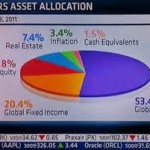
The investment committee of the $265 billion California Public Employees Retirement System (CalPERS) is evaluating the impact of fees it is paying for active management and whether those fees are justified, according to a report in Investment News.
The problem is that it is expensive and problematical to pick the right active managers who will beat the market. Even when the right managers are chose (those that beat their benchmarks), those gains are often offset by other managers who fail to deliver above-market returns.
According to CalPERS investment consultant Allen Emkin, only about 25% of active managers are beating their benchmarks at any one time. Even when the other 75% are under-performing they all have to be compensated and that is a major problem.
This explains why total assets in passive equity mutual funds and ETFs now exceed $2 trillion, an increase from $534 billion a decade ago, according to Lipper. Investment News also said that since 2003, investors have pulled $287 billion from actively managed equity funds, while investing just over $1 trillion into passive funds.
Fees Are Paramount to Performance
As a former reporter for Pensions & Investments in the early-1980s, the publication which broke the CalPERS story, I followed CalPERS and their systematic, diligent investment approach. Yet these same questions–the debate about active vs. passive management and costs–were being raised then.
The main difference today is that CalPERS’ assets have grown significantly since then, so their manager fees have skyrocketed. Fund administrators are evidently seeing they are paying millions in manager fees for nothing. Naturally, this is one discussion the active management industry wants to avoid, even though it has been going on for at least 30 years.
While the amounts paid in manager fees are vastly different, this same situation exists for individual investors who over-pay for manager performance and services they they don’t receive in their 401(k)s and, to a lesser extent, in their other non-retirement individual accounts.
So the message here is simple: fees definitely matter. If investors don’t know what they are paying in fees and whether the services they are getting are worth it, they are being disadvantaged by their 401(k) plan administrators.










